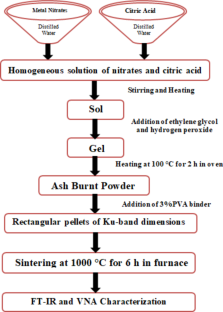Comparative study of Mn2+ and Zr4+ co-substituted Zn-Co spinel ferrites as microwave absorbing materials in Ku (12.4–18 GHz) and K (18-26.5 GHz) frequency bands
Abstract
The present research work aims to address the rising demand for microwave-absorbing materials (MAMs) due to the relentless growth of detrimental electromagnetic wave pollution. Herein, the absorption behavior of manganese-zirconium co-substituted zinc-cobalt spinel ferrites with chemical composition Zn0.25Co0.75(MnZr)xFe2−2xO4 (0.05 ≤ x ≤ 0.25, ∆x = 0.05) were investigated in the Ku (12.4–18 GHz) and K (18-26.5 GHz) frequency bands. Samples of Mn-Zr-Zn-Co ferrites were successfully synthesized via the sol-gel citrate route with sintering at a temperature of 1000 °C for 6 h. Fourier transform infrared spectroscopy (FT-IR) confirmed the presence of two vibrational peaks in the spinel lattice structure. The complex dielectric permittivity and complex magnetic permeability were measured using a vector network analyzer (VNA). The composition MZ 0.15 outperformed all the prepared compositions by exhibiting a minimum reflection loss of -34.55 dB at a matching frequency of 15.09 GHz and a matching thickness of 2.7 mm in Ku-band and a reflection loss as low as -30.40 dB at a matching frequency of 25.48 GHz and a matching thickness of 1.5 mm in K-band. The obtained results indicate that the fabricated specimens have the potential for designing efficient microwave-absorbing materials in the Ku and K frequency bands.


 求助内容:
求助内容: 应助结果提醒方式:
应助结果提醒方式:


